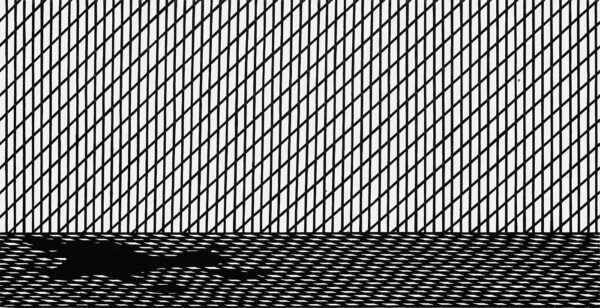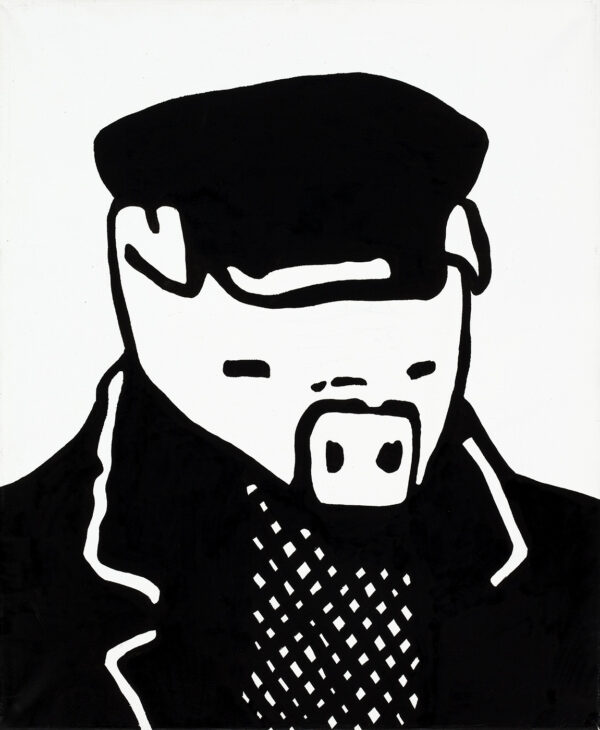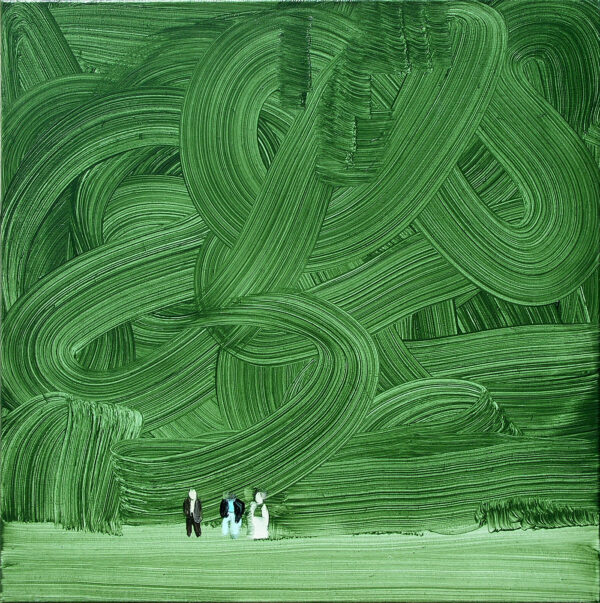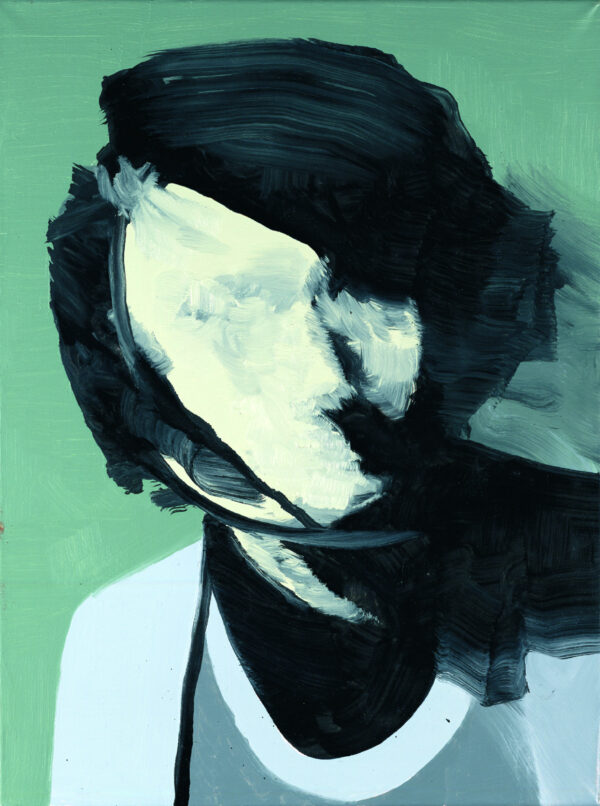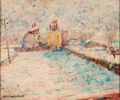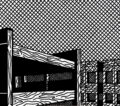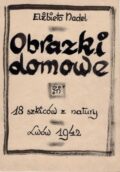
Title
Wilhelm Sasnal’s Transitional Images
https://www.doi.org/10.48285/8kaewzjo3p
https://miejsce.asp.waw.pl/en/english-wilhelm-sasnals-transitional-images/
Abstract
In her article the author offers a reframing of the discussion of how communities productively deal with their troubled pasts. The case in question is that of the post-war Polish national community, and its refusal to face so-called dark sides or shameful episodes of the historical past. The author concentrates on Wilhelm Sasnals’ artworks which deal with this gloomy heritage and reinterprets them in light of Donald W. Winnicott’s concept of transitional objects (as transitional images) thus pointing towards new possibilities in finding ways out of both discursive, political and pedagogical impasses in collective memory in Poland.
DOI
“I believe cure at its root means care.”1
From the mid-1990s onwards the visual arts in Poland have been responding to a changing memory culture shaped in the aftermath of the political and social transformation of 1989. Art’s potential for addressing the most troubling, contested and painful elements of collective identity seems unique. Its ability to cause productive confusion both on a cognitive and affective level cannot be overestimated, even if the immediate public response, encouraged by misunderstanding and refusal, might be disappointing and frustrating. The public have oftentimes felt offended or wounded as a result of a confrontation with strongly suppressed ambivalence about its own position vis-à-vis traumatic historical events such as the Holocaust, related memory and affect towards those to whom it happened, and towards oneself. Conflicts over who we are—as a historical collective—cannot be resolved solely by art, but it is through artistic mediation that many ambivalences can be addressed, wounds opened, feelings hurt, competitive and conflicting narratives expressed without necessarily destroying one another. Artistic gestures intervene in and question what Jacques Rancière called the “distribution of the sensible” i.e. “the system of self-evident facts of sense perception that simultaneously discloses the existence of something in common and the delimitations that define the respective parts and positions within it.”2 Artists, as well as art curators and critics, have been participating—by means of individual and group interventions in public space, memorial and counter-memorial gestures3—in the debate (at times quarrel) about the role of the past, especially the legacy of World War II and the Holocaust, Polish memory of the Holocaust, and specifically the “Polish” position—that of bystanders.
Philosopher and psychotherapist Andrzej Leder has recently initiated an “exercise in historical logic,” arguing that this be understood as a specific kind of experience, akin to what I would describe, paraphrasing his publication title, as “sleepwalking through a revolution.”4 According to the author, 1939–56 in Poland was a period of radical social revolution, which has remained unconscious, in spite of brutally and totally transforming the fabric of Polish society, becoming responsible for today’s class, economic and symbolic state of affairs.5 He emphasizes the significance of the Holocaust in this process, its consequences and implications, which seem to be insufficiently acknowledged, if not tabooed, not only in public, but also academic discourse. The key issue here is the question of disidentification (it was not us) and passive experience, which pushes the (non)experiencing community to treat that which has happened as not their own, and therefore not really existent. Consequently, Leder claims, we are (already) dealing with “the history of constructing false identities and establishing erroneous hierarchies of goals and values.”6 It thus seems indispensable for the Polish community to recognize its own role in history, to acknowledge a genealogy, which might not be easy to accept, and to assume responsibility (for the past and future, for oneself, but also for others—which is in turn connected with the postulate, and perhaps even imperative, of empathy).
The authors of Przemoc filosemicka [Philosemitic Violence], Elżbieta Janicka and Tomasz Żukowski, point to “narrative shocks” [wstrząsy narracyjne]—a phenomenon which could be related to raptures or shifts in Rancière’s distribution of the sensible—which disturbed Polish collective memory and identity alike. The first emerged in the second half of the 1980s in the aftermath of Claude Lanzmann’s Shoah (1985)7 with the case of the female Carmelite convent in Oświęcim8 (1985–1993) and with Jan Blonski’s essay Biedni Polacy patrzą na getto [The Poor Poles Look at the Ghetto] (1987).9 The core of this narrative shock was—the authors claim—the “impossibility to further ignore the fact that Poles were not the only, nor the main victim of WWII, even in the occupied Poland. And that the main victim was the Jews in occupied Poland and Europe alike.”10 The 1990s brought to public attention the problem of the ambivalent attitudes of Poles to Jews during World War II by means of: Michał Cichy’s press article (Gazeta Wyborcza, 1996) on the killing of Jews by soldiers of the Home Army (AK) during the Warsaw Uprising;11 celebrations of the 50th anniversary of the Kielce pogrom (1996); installment of religious symbols (crosses) on the field of ashes in Brzezinka (Birkenau) (1996–97) as well as the presence of the Papal cross on the gravel pit in Auschwitz (1998–1999).12 Janicka and Żukowski call these almost two decades the first period of narrative entropy and endless social tension. The culmination of which came with the new millennium and the publication of Jan Tomasz Gross’ Sąsiedzi: Historia zagłady żydowskiego miasteczka [Neighbors. The Destruction of the Jewish Community in Jedwabne, Poland] (2000).13 This time the narrative shock is related to information which despite already being known to historians now becomes public fact: the knowledge of complicity, the awareness that Poles not only were not innocent victims, but that they were also active as perpetrators. Despite this rupture having negative consequences, Janicka and Żukowski stress a point which should not be overlooked, that it also brought with it a new beginning, a creative and constructive formation of new research parameters and institutions, new academic sub-disciplines and genres, and new scholarship offering reinterpretations in the study of Polish society and culture.14
In 2001, 15 years after its American premiere, Art Spiegelman’s graphic novel Maus was published in Polish translation (by Piotr Bikont). It is a biographical graphic novel recounting the history of the narrator’s parents and their survival of the Holocaust, their emigration from Poland, the mother’s suicide, etc. The characters in the book are drawn according to an animal schema: Jews as mice, Germans as cats, Poles as pigs and Americans as dogs. It addresses both the traumatic past of the Holocaust as well as the problematic attitude of Polish citizens towards Jewish people before, during and after World War II, the problem of Polish antisemitism as well as a competing narrative of war suffering. The publication of the Polish translation was accompanied by public protests (on the part of right-wing and nationalist organizations, including former concentration camp inmates) in front of the office of the Przekrój illustrated magazine, whose editor in chief was Maus’ translator. The magazine devoted the cover of one of its issues as well as significant number of pages to Spiegelman and his work. Both the author and his translator were accused of “anti-Polonism,” and depicting the Polish nation as co-responsible for the Holocaust. The street protest ended in the symbolic destruction of the book and the association Narod-Panstwo-Niepodleglosc [Nation-State-Independence] sued the Polish publisher for defamation of the Polish nation.15 It was feared that as Maus was artistically powerful, suggestive in its form and content, it might become a source of historical knowledge about Polish complicity in the Holocaust (a fact which had to be rejected).
Inspired and interpellated—artistically by Spiegelman’s work, and ethically-politically by the public dispute—visual artist, artist-as-citizen, Wilhelm Sasnal, offered a painterly interpretation of page 157 from Spiegelman’s Maus as a mural when invited by curator Adam Szymczyk to participate in an exhibition entitled “Zawody malarskie”16 in a gallery in Bielsko Biala. This is an episode in the narrative where Vladek Spiegelman encounters a Polish szmalcownik. The scene was depicted by Sasnal without characters: one could only see/read the textual captions arranged on the “page.” The mural was intended to be on the wall of the Bielsko-Biała Museum of Technology (which is located in a former factory—in the book the setting is Spiegelman’s factory), but the artist did not get the necessary permission. Finally, it was painted on the back wall of the gallery, located on the site of a synagogue ruined by the Nazis.17 The painting and the exhibition were also met with protests and legal complaints on the part of local nationalist and right-wing organizations. Members of the Christian National Union (ZCnH) political party complained about “anti-Polish motives present in the public space of Bielsko,” they addressed the director of the gallery demanding the work’s removal, claiming that it was based on a false premise that “Poles denounced and turned in Jews to Germans,” a premise which it has been known for a while now is a historical fact.
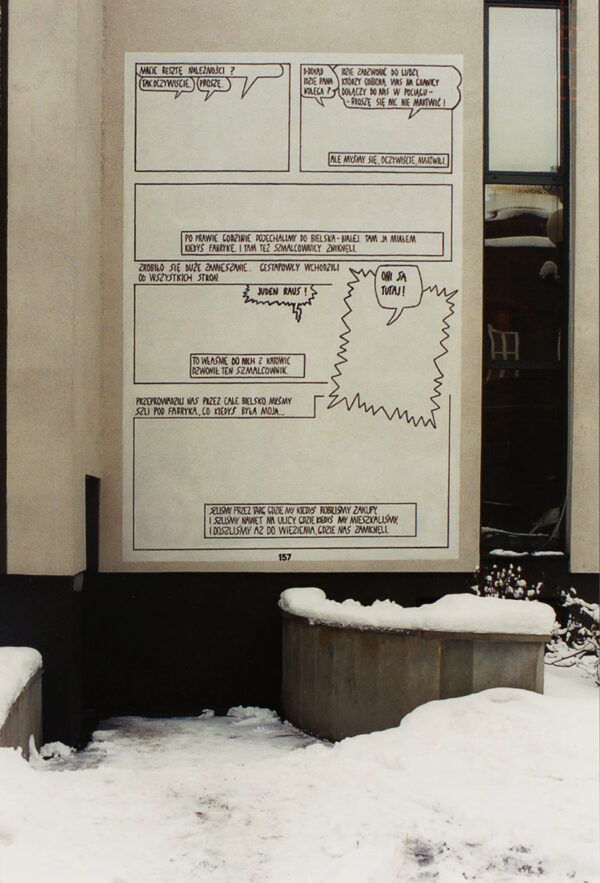
Wilhelm Sasnal, “Maus”, mural, 2001, Galeria Bielska BWA (Bielsko-Biala, Poland) for the exhibition “Zawody malarskie” [“Painting Contest”]
curator Adam Szymczyk, photograph Grażyna Cybulska.
Besides the mural in Bielsko-Biała, a site-responsive intervention, Wilhelm Sasnal also painted several canvas-based works inspired by Spiegelman’s graphic novel: canvases of various formats, in which the artist reproduced and interpreted selected visual motifs.18 These paintings do not have individual titles; one of them is a portrait, the rest depict fragments of floor, walls, camp bunk beds. At first glance it is hard to tell what we are actually looking at and precisely why we are shown these motifs. What in Spiegelman’s graphic novel was the corner of a room, in Sasnal’s painting seems to be a combination of abstract patterns. However, there is a painting in this series which seems unique and powerful: it is smaller than the other paintings, and it is a portrait. Spiegelman’s protagonist (the aforementioned szmalcownik) whom the author of Maus left only partially drawn (in the graphic novel the Pig in question is shown only in passing, on his way out of the frame, just half of his face visible), is rendered in full by Sasnal. He is not so much reproduced as produced. Sasnal fills his canvas with this one face thus creating a disturbing portrait of a wartime Pole (after Spiegelman), or maybe a belated self-portrait? By giving a face to the protagonist from page 155 (English edition) the artist not so much appropriates a motif from Maus as takes responsibility for it. The ordinariness of this portrait and lack of unnecessary pathos suggest an interpretation which moves away from treating this gesture as one of expiation to rather one of retrospective self-inspection. The artist returns to the ambivalent position between acknowledging historical oppression and the oppressive experience of this knowledge in the present. “How could I live freely without coping with this?” he asks rhetorically in one interview.19 His way of coping was by copying and adapting these images of the troubled past.
Emphasizing the heterogenous nature of Sasnal’s work and the presence of motifs from various sources, both real and imagined, curator Adam Szymczyk has claimed that the logic behind the artist’s choices is that of “the desire to touch shame”20—shame of ignorance (not knowing what actually happened at the right time) and shame of being implicated (of being part of a community whose members did wrong and refused to acknowledge it)—to face what has been hidden, covered and repressed. Sasnal does not seem to be interested in or devoted to shameless exposure of collective guilt, rather he intertextually reworks visual motives already present in the public sphere, in an act of self-imposed civic and artistic duty: “it cannot change the world, it helps me to understand, to describe the world, it is but an attempt and it might be bound to fail.”21 Sasnal does not accuse, he rather spins a visual reflection on the position of the bystander, on the role of the one who comes after and on the condition of this belatedness.
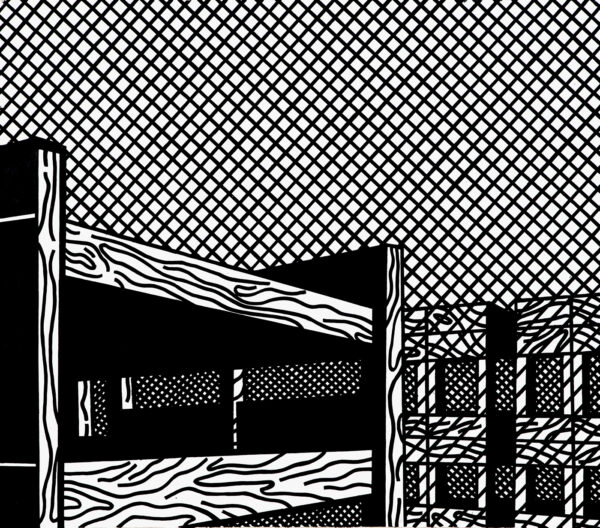
Wilhelm Sasnal, “Maus 4”, 115 × 130 cm, oil on canvas, 2001, kolekcja Muzeum Historii Żydów Polskich POLIN w Warszawie [POLIN Museum of the History of Polish Jews collection].
I am not investigating here the artist’s intentions, but rather intensities accompanying the work’s production and its reception. My conviction is that an effective artistic gesture does not intentionally aim at a particular end. What should be especially appreciated about Sasnal’s images is how they record an encounter: the artist facing particularly emotionally and ethically charged space, full of ambivalences. Hence I am aiming here to shift the stress on how these images can possibly act, how one imagines their effectiveness in the situation of a discursive and political impasse as described above. They do not reconstruct the events of the past, nor do they serve as self-analysis of the artist, even less so an occasion for group therapy. These images do not accuse, nor do they judge or call for action. In themselves they have no intention or agency whatsoever. They are simply out there and—equally important—their forms of being are multiple: they are images on canvases, in public space, filmic images; they are images stored in the people who saw them, who liked or hated them. As such they are resilient, even more and paradoxically so when they become objects of destruction or hatred. Each such attempt carries with it a moment of intensity and an affective charge which allows for a more insistent inscription of these images.
An Excursus on Shame
Yet, to return to Szymczyk’s idea, how are we to understand the need to touch shame? Is touching shame about experiencing it personally or interpersonally? Is it about painting it or painting with it? Is the “touching” an attempted communication or communion with the past which by many has been labelled as untouchable? What is actually being communicated here if we agree with Sylvian Tomkins that “Shame is both an interruption and a further impediment to communication, which is itself communicated. When one hangs one’s head or drops one’s eyelids or averts one’s gaze, one has communicated one’s shame and both the face and the self unwittingly become more visible, to the self and others.”22 “There is something extremely neutral in communication by means of a line and a spot, after all, it is the most basic form of expression”23 says the artist. Sasnal is not communicating shame, nor is he trying to shame the community he belongs to as an exception rather than as a representative. His paintings seem to be coming to life through an encounter with shame which is neither staged nor reproduced for others. When seen through the Tomkinsian prism this painterly practice offers everyone her/his own shame-full moment, yet at the same time, because the images Sasnal works/plays with are public, shared images, this moment is never merely individual, always already in relation to others and their moments. Hence this self-reflexivity related to shame also becomes an experience (or potentiality) of intersubjectivity.
Touching shame on canvas may also mean detaching from a scene which was supposed to give pleasure by confirming one’s belonging to a community and one’s identity and self-image in relation to history. The degree of being inside and outside the collective body is negotiated here precisely by “the blush”: as Eve Kosovsky Sedgwick and Adam Frank put it:
only a scene that offers you enjoyment or engages your interest can make you blush. Similarly, only something you thought might delight or satisfy can disgust. Both these affects produce bodily knowledges: disgust, as spitting out bad-tasting food, recognizes the difference between inside and outside the body and what should and should not be let in; shame, as precarious hyperreflexivity of the surface of the body, can turn one inside out—or outside in (my italics).24
I would like to see that precarious hyperreflexivity as a condition of the individual and collective body, and as one which by being so closely related to the surface (image) also implies the making and receiving of images. Following Sedgwick and Franks’ reflection on Tomkins’ theory of shame-as-affect, one could think of Sasnal’s painterly practice as a process whereby he “punctuates” himself as distinct from the collective body, while at the same time being open to it and absorptive. “Perhaps along with contempt and disgust it [shame] can be a switch point for the individuation of imaging systems, of consciousnesses, of bodies, of theories, of selves; an individuation that decides not necessarily an identity but a figuration, distinction, or mark of punctuation.”25 It seems it is so in this case.
Marking his distinctiveness Sasnal at the same time admits his “being from here.” Interestingly enough he rarely talks about being part of a community, even less so of the nation, but rather of belonging to a place (krajowiec),26 being from a specific landscape and very often in his painting it is the concentration and visual meditation on the landscape which allows him to depart from the “facts”—from being literal or didactic—and towards creating atmospheres, occasions for revisiting the troubled past together with its ambivalences, and the “pain-points” of post-war, post-traumatic experience.27 This is the case not only of his Maus-inspired paintings but also of several other works created in the last two decades, including paintings from 2003 relating to Lanzmann’s Shoah: Forest and Translator, the 2010 painting Untitled (from the movie “The Beater”) which reinterprets a still from 1963 movie The Beater (directed by Ewa and Czesław Petelski)28—an ambiguous World War II narrative about a group of Hungarian Jews who managed to escape during transport to an extermination camp, hid in the Polish countryside and got caught in a “hunt” organized by the Nazis (with the assistance of Poles)—and finally, in a feature film Sasnal co-authored with his wife Anka, It Looks Pretty from a Distance (2011), which was a response to Gross’ Neighbors. In re-making historical motifs Sasnal appropriates and defamiliarizes them. He responds to the reality of these images as well as to the historical reality which brought them to life: the reality of their making in the first place and the reality of the events they refer to. Historicity here is envisioned as complex and confusing, memory as vicarious and ambivalent.
When revisiting Shoah Sasnal selects two motifs: that of landscape and that of translation. The latter as in the case of Maus is a portrait (actually two portraits): this time the blurred, disquieting face of Barbara Janicka, the Polish female translator of Lanzmann who remains present in front of the camera throughout many scenes in the film and whose voice also has an exceptional presence in its soundscape.29 The translator is exposed on many levels in the film and her “role” in the transmission of the narrative of Polish bystanders is far from neutral, innocent or clear. In the painting her face has no distinct features, nothing to get hold of except the blur. The blur here is a rupture, an impediment to communication. What are we to make of it? Why would the translator be of interest, where are we today in relation to this figure, this cultural position? Are these two experiences of the Holocaust: that of Jewish victims/survivors and Polish witnesses/bystanders, translatable to one another, without being blurred? Is Sasnal playing with here another possibility of self-portraiture?
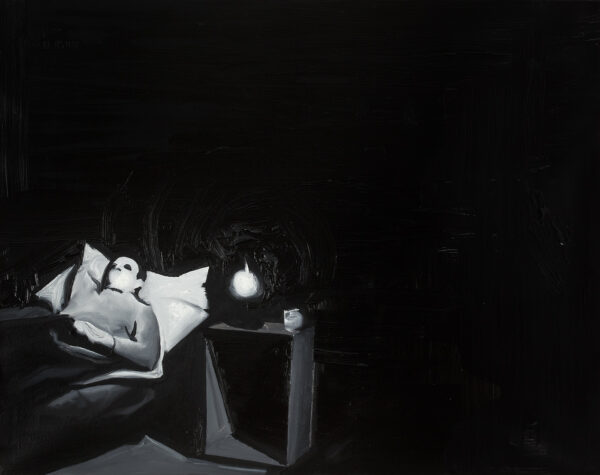
Wilhelm Sasnal, “Untitled (from the film “The Beater”)”, 55 × 70 cm, oil on canvas, 2010, kolekcja Muzeum Sztuki Nowoczesnej w Warszawie [collection of the Modern Art Museum, Warsaw].
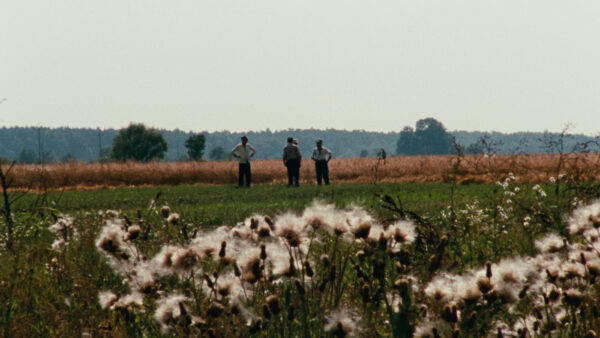
Wilhelm Sasnal, Anna Sasnal, “Z daleka widok jest piękny” [It Looks Pretty from a Distance], color film with sound, 77 mins, 2011.
The state triggered by these paintings might be that of “precarious hyperreflexivity”: the blur replacing the face, an undefined smoke—a stain on the landscape—thick brush strokes lurking in the background and consuming what is in the fore—nothing is certain, everything might be resonant, offering the disquieting experience of “turning one inside-out.” One cannot capture the event on the canvas, it is close to illegibility, the visual referent, the source image if there ever was one, is distanced and estranged. It is not about recognition, I would claim, nor is it about reparation. In struggling with the role Sasnal’s Holocaust afterimages play in the Polish cultural landscape, I would like to conceptualize them as resilient images: images stuck in our heads, images which won’t go away, images that overshadow all other images, or a lack of images that overshadows any image available to our collective memory and identity. We hate them and yet we need them in order to grow into a better understanding of who we are and what our collective self-image is. In formulating this conception, I will employ D. H. Winnicott’s account of transitional objects. As preposterous as this might seem at first, I hope to show that this approach might offer a new solution to the problem of narcissistic closure in the face of collective investment in a grandiose self-image of oppressed victim, and the repetition compulsion necessitated by the need for its ceaseless validation.
Transitional Images
Social psychologists’ studies show that when it comes to national collective identities, we can observe a narcissistic orientation which is related to a so-called blind patriotism, characterized as an “uncritical idealization of the nation”:
collective narcissists are expected to be particularly prone to interpret the actions of others as signs of disrespect, criticism, or disapproval of an ingroup and to react aggressively. They are also expected to react aggressively to actual criticism and other situations that threaten a positive image of an ingroup. They are expected often to feel unfairly and unjustly treated in an intergroup context (…) (they) are not willing to forgive and forget previous insults or unfairness to an ingroup from other groups. Thus, they are likely to hold prejudice toward outgroups with whom they share a history of mutual grievances and wrongdoings.30
As research in the field of social psychology proves, collective narcissism is fixated on “validating and protecting the group’s image (rather than securing its dominant position).”31 This image, it is argued, does not necessarily have anything to do with the group’s “power, social status, or economic dominance,”32 the investment in the image works to protect the group against anxiety, ambivalence or discomfort related to the group’s actual position, its wrongdoings and failures. Narratives on crimes committed in the past seriously destabilize the self-image and trigger negative collective emotions, seriously threatening positive social identity. According to Michał Bilewicz, a researcher associated with the Warsaw University Center for Research on Prejudice, when confronted with the past wrongdoings of their national group (in relation to colonialism—Dutch, Belgian, British and Portuguese; in relation to genocide—German, Serbian, Rwandan), its members have rarely reacted with feelings of guilt or shame, and rejected collective responsibility.33 Bilewicz points to a breach between the declarations and rituals performed in the public sphere by public individuals (such as political leaders), and the actual public feelings the respondents expressed, and investigates possible reasons. The case he discusses in detail is that of the Polish community and the (non)memory of the crimes committed against the Jews during the Holocaust and shortly after, in particular the mechanisms employed in reaction to the public debate on the Jedwabne crime in the aftermath of the publication of Gross’ Neighbors. Bilewicz observes that in response to the unwanted knowledge, a whole variety of strategies regulating negative emotions came into play, including shifting attention to other episodes of collective history, avoiding or discrediting the source of the unwanted knowledge, modifying the situation or excluding from the community those who would threaten the (idealized) collective self-image, as well as attempts at censorship.34 These strategies, the author concludes, are correlated with cognitive reinterpretations: effective regulation of emotions (ultimately repressing guilt and shame) translates onto the regulation and disciplining of knowledge production and transmission. Omissions, repressions and censorship however partake in creating and transforming the image of the community and not its core. The very fact that these events and negative emotions associated with them do not surface does not mean they have been removed or ceased to impact the community in question.
The fundamental question here is thus: how to make people who remain narcissistically attached to the phantasy of their innocence (and victimhood), acknowledge historical facts and embrace the negative emotions which emerge in the aftermath of such painful knowledge? Bilewicz suggests a rather straightforward and surprisingly shortsighted solution to this dilemma. On the one hand he claims eliminating emotions from public discourse on troubled past (stressing instead historical facts and their interpretations) would do the job, on the other he suggests introducing and promoting collective identities other than, and equally powerful too, the national one.35 However, nowhere do we find any suggestion where these identities might originate from or how they would be made to work. The belief in the power of objective, emotionless historical explanation itself sounds like a symptom of phantasmatic attachment—this time to the power of rational communication. Moreover, it also seems based on a rather conservative approach to education and pedagogy. If one takes a look at progressive trends in humanities, however, it is doubtless that emotions (seen not as the mere reverse or negation of rationality) prove crucial for inclusive, reparative and emancipatory pedagogy, as well as political movements.
For a researcher who thinks and feels from within the structures of cultural memory, and who finds inspiration in psychoanalytical theories creatively reinterpreted by contemporary artistic practices, another path seems much more promising as a way out of this Gordian knot of denial and regression verging on despair. I would like to reach beyond the paradigm which has provided me with tools to read art as an ethical and epistemological corrective to the dominant order and power, as a provider of alternative cognitive procedures, as interventional, pedagogical, critical and self-critical agency. I would like to treat the images Sasnal offers as transitional objects, or better—transitional images which allow us to know a reality beyond ourselves. The model for this process is that of object relations as described by Donald W. Winnicott, English pediatrician and developmental psychoanalyst. What might at first sound like a preposterous analogy—that between art images and early childhood objects—will hopefully provide some new structures for thinking about the work images do in our coming to terms with past traumas, and our own troubled collective self-image.
I do not intend to claim transitional images as necessarily more effective or successful, rather I focus on providing an alternative way of framing the question of how the troubling past can become our own today, how mechanisms of refusal and rejection can be tamed or countered. Artistic operations, because they employ registers so different from those of historical knowledge or moral codes, can be ambivalent and ambiguous; they do not need to present or explain facts. Art introduces intensities, potentially productive confusion both cognitive (we do not know what we are looking at) and emotional or moral (what should we feel about it). Transitional images in particular, and Winnicott’s theory more generally, allow me to approach issues of the Holocaust’s vicarious memory in Polish visual arts after 1989, not to provide the best analysis of the phenomenon in all its complexity, but rather to contribute to the many analytic strategies employed so far in both academic and art critical writing, in order to create as exhaustive and comprehensive a picture as possible of how visual culture partakes in the formation of memory culture.
In Winnicott’s account of a child’s early development, relating to an object plays an exceptional role. Transitional objects such as a blanket or a teddy bear allow the baby to learn and manage reality beyond herself—relating to such an object involves working with emotions, which help in navigating a world outside of oneself. In coming to terms with this world, the baby has to deal with frustration, anxiety and rage at the fact that she is separated from the caregiver.36 As Winnicott observes, after the baby relates to an object, she destroys it, and once the object survives this attempted destruction, it becomes an external object per se: “Survival of the destruction, places the object outside the area of objects set up by the subject’s projective mental mechanisms. In this way a world of shared reality is created which the subject can use, and which can feed back other-than-me substance into the subject.”37 During the process of object-relating, Winnicott convinces us, the subject changes and the object gains meaning (affective charge; projection mechanisms and identifications come into play), and becomes a target of destructive power:
The subject says to the object: “I destroyed you,” and the object is there to receive the communication. From now on the subject says: “Hullo object!” “I destroyed you.” “I love you.” “You have value for me because of your survival of my destruction of you.” “While I am loving you I am all the time destroying you in (unconscious) fantasy.” Here fantasy begins for the individual. The subject can now use the object that has survived. (…) In these ways the object develops its own autonomy and life, and (if it survives) contributes-in to the subject, according to its own properties.38
The process of the object’s becoming destroyed is simultaneously the process of becoming real (not a mere phantasy), becoming part of “shared reality,” possibly becoming shareable. And so, Winnicott continues, the usage of an object requires coming to terms with its independent existence (“its property of having been there all the time”),39 with externality itself. It is a process “more sophisticated than a capacity to relate to objects.”40 The fact that the object has survived confirms the existence of the outside world, its stubborn existence and its persistence, and its saves the subject from the feedback loop of his/her projective mechanisms. The object as an element of a shared reality can be used by the subject to further develop.
According to political theorist, Bonnie Honig, who stresses the importance of resilience in Winnicott’s developmental theory and who employs it in her elaboration of democratic resilience, the capacity to survive destruction is both a trait we grant to the object (in fantasy) and a trait we acquire from objects, by way of a kind of (unnamed) transference. (…) Resilience is what the autonomous object “contributes-in to the subject, according to its own properties.” This happens when there is a “holding environment” that allows these transactions or transferences to occur. One of the things that a holding environment does is to offer up objects.41
The holding environment as Winnicott envisioned it is a social context which enables maturing because it offers care; first it is parental care and later on political, social and cultural institutions.42 Care offered by cultural and artistic practices may not be as obvious or as straightforward, nor can it be precisely planned and measured, yet it is there. The holding environment provides a site for shaping individual and collective agency by means of which subjects can attempt to transform the status quo in ways that are creative, or even hitherto unheard of, despite the hardships they have experienced. A holding environment is not a given, nor is it a constant. It transforms, and it can be transformed by practices emerging in the face of radically and at times catastrophically changing reality.
Could we think of works of art (in this case Sasnal’s works which touch on the Holocaust and Polish complicity) as transitional images? And what exactly would it mean (for us and for the art object)? If, as we have seen, confronted with its negative image, the collective subject withdraws from reality and regresses to infantile phantasy, a transitional image could first of all provide an occasion for coming to terms with the world outside this phantasy, the world of unwanted historical knowledge. These paintings do not show reality as it was (or is), nor do they demand a recognition of facts, nor do they impose any kind of knowledge. Rather, as quite obscure image-objects, they can take in rage, frustration and anxiety, they can be rejected and “destroyed,” censored and denied, yet the more the collective subject destroys them, the more they become real and as such impossible to ignore, and as such—objects for use.
Art is not superfluous when it comes to the discussion of how attitudes to the troubled past are shaped and transmitted; it might actually turn out to be more effective than other forms of communication, as the defense mechanisms in place (rejecting factual knowledge and rational argumentation) do not seem to work, the effectiveness of images which disturb or even violate our sense of ourselves is not over when the image is covered, erased or censored. The resilience of these images might be the actual power of art-images, which act a lot like images in general but with an important difference: their real meaning cannot be reduced to the reality outside of them.
As Honig has rightfully pointed out: “The stability of transitional objects derives from their enchanted condensation of, and entry into, complicated sets of affective relations underwritten by affective, relational environments and, ultimately also by fantasy.”43 Using these image-objects allows for reworking one’s attachments to stable norms and forms of collective subjectivity. It is not a didactic process, yet it is about accepting (self)knowledge. As has been said, surviving destruction the object empowers the subject in its process of maturation, in its quest for “health.” Once introduced in relation to the collective subject such objects—painted or filmed by the artist—will remain as resilient elements of the outside world, ready to be used. They are out there as images (virtually) and as material objects. As such they tend to partake in more than one shared reality. As such they are also part of a holding environment—though at first sight it may seem rather more hostile than holding—the “public things” that, as Honig put it, “transition us not just into psychic maturity (…) but into democratic collectivity.”44 The holding environment that contemporary art offers in the context of working through Poland’s troubled past, supplements the institutions traditionally responsible for collective (historical) identities such as school, family, and the Polish Catholic Church. None of these has ever explicitly and comprehensively rejected a narcissistic and fundamentally false self-image nor taken responsibility for introducing an alternative one. It takes an emancipated artist or an angry child to demand a world outside this phantasy and to playfully engage with it.
Images of Wilhelm Sasnal’s works courtesy of the artist. I whole heartedly thank the artist for the permission to use these images, and Paweł Gardynik for preparing them for publication.
Research and work on the article within Horizon2020 project RePAST Revisiting the Past, Anticipating the Future (Research and Innovation Program under Grant Agreement no 769252) www.repast.eu.
Bibliography
Alphen, Ernst van. Art in Mind: How Contemporary Images Shape Thought. Chicago: University of Chicago Press, 2005.
— “Playing the Holocaust.” In Mirroring Evil. Nazi Imagery, Recent Art, exh. cat., edited by Norman L. Kleeblatt, 65–83. New York: Jewish Museum, 2001.
Bilewicz, Michał. “(Nie)pamięć zbiorowa Polaków jako skuteczna regulacja emocji.” Teksty Drugie, no 6 (2016): 52–67
— “The Dark Side of Emotion Regulation: Historical Defensiveness as an Obstacle in Reconciliation.” Psychological Inquiry, no. 2 (2016): 89–95.
Cichy, Michał. “Polacy–Żydzi: czarne karty powstania.” Gazeta Wyborcza, 29 January, 1996.
Eichler, Dominic, Andrzej Przywara, and Jörg Heiser. Wilhelm Sasnal. London–New York: Phaidon, 2011.
Forecki, Piotr. Od „Shoah” do „Strachu.” Spory o polsko-żydowską przeszłość i pamięć w debatach publicznych. Poznań: Wydawnictwo Poznańskie, 2011.
Głowacka, Dorota. “Współ-pamięć, pamięć ‘negatywna’ i dylematy przekładu w ‘wycinkach’ z Shoah Claude’a Lanzmanna.” Teksty Drugie, no. 6 (2016): 297–311.
Gross, Jan Tomasz. Sąsiedzi: Historia zagłady żydowskiego miasteczka. Sejny: Fundacja Pogranicze, 2000.
Honig, Bonnie. “Resilience.” Political Concepts, https://www.politicalconcepts.org/honig-resilience/2/
Janicka, Elżbieta, and Tomasz Żukowski. Przemoc filosemicka. Nowe polskie narracje o Żydach po roku 2000. Warsaw: Wydawnictwo IBL PAN, 2016.
Kosiewski, Piotr, ed. Pamięć jako przedmiot władzy. Warsaw: Fundacja im. Stefana Batorego, 2008.
— ed. Sztuka jako rozmowa o przeszłości. Warsaw: Fundacja im. Stefana Batorego, 2009.
— ed. section: “sztuka.” Kresy 3 (2008): 182–212.
Kosiewski, Piotr, and Wilhelm Sasnal. “Malarz historyczny? z Wilhelmem Sasnalem rozmawia Piotr Kosiewski.” Kresy 3 (2008): 207–212.
Kosofsky Sedgwick, Eve, and Adam Frank. “Shame in the Cybernetic Fold: Reading Silvan Tomkins.” Critical Inquiry, no. 2 (Winter, 1995): 496–522.
Kowalczyk, Izabela. Podróż do przeszłości. Interpretacje najnowszej historii w polskiej sztuce krytycznej. Warsaw: Wydawnictwo SWPS Academica, 2010.
Leder, Andrzej. “Kto nam zabrał tę rewolucję?” Krytyka Polityczna, no. 29 (2013): 32–39
— Prześniona rewolucja. Ćwiczenia z logiki historycznej. Warsaw: Wydawnictwo Krytyki Politycznej, 2014.
Polonsky, Antony, ed. My Brother’s Keeper: Recent Polish Debates on the Holocaust. London: Routledge, 1990.
Ranciere, Jacques. The Politics of Aesthetics. The Distribution of the Sensible. Translation and introduction by Gabriel Rockhill. New York-London: Continuum, 2004.
Sasnal, Wilhelm, and Jakub Banasiak. 15 Stuleci. Wolowiec: Wydawnictwo Czarne, 2017.
— Sasnal. Przewodnik Krytyki Politycznej. Warsaw: Wydawnictwo Krytyki Politycznej, 2008.
Sasnal, Wilhelm, and Luc Tuymans. “When Luc Tuymans Met Wilhelm Sasnal…” Art Review 19, (2008): 42–49.
Tomkins, Silvan. Shame and its Sisters: A Silvan Tomkins Reader (Selections from the four volumes of Affect, Imagery, Consciousness). Edited by Adam Frank and Eve Kosofsky Sedgwick. Durham, NC and London: Duke University Press, 1995.
Winnicott, Donald W. The Maturational Processes and the Facilitating Environment. London: Karnac Books, 1990.
— Playing and Reality. London–New York: Routledge, 2009.
— Home Is Where We Start From. London: Norton, 1986.
Zavala, Agnieszka Golec de, Aleksandra Cichocka, Roy Eidelson, and Nuwan Jayawickreme. “Collective Narcissism and its Social Consequences.” Journal of Personality and Social Psychology, no. 97/6 (2009): 1074–96.
Żukowski, Tomasz. Wielki retusz. Jak zapomnieliśmy, że Polacy zabijali Żydów. Warsaw: Wielka Litera, 2018.
- D. W. Winnicott, “Cure,” in Home Is Where We Start From (London: Norton, 1986), 112. ↩︎
- Jacques Ranciere, The Politics of Aesthetics. The Distribution of the Sensible, trans. and intro. Gabriel Rockhill (New York-London: Continuum, 2004), 12. ↩︎
- By now the archive of these practices is quite immense. See, among others: Izabela Kowalczyk, Podróż do przeszłości. Interpretacje najnowszej historii w polskiej sztuce krytycznej [A Journey Into the Past. Interpretations of Recent History in Polish Critical Art] (Warsaw: Wydawnictwo SWPS Academica, 2010); Piotr Kosiewski, ed., Pamięć jako przedmiot władzy [Memory as a Tool of Power] (Warsaw: Fundacja im. Stefana Batorego, 2008); Piotr Kosiewski, ed., Sztuka jako rozmowa o przeszłości [Art as a Conversation About the Past] (Warsaw: Fundacja im. Stefana Batorego, 2009); Section: “sztuka,” [art] in Kresy 3 (2008), and numerous other academic and critical articles. ↩︎
- Or a “slept-through revolution.” See: Andrzej Leder, “Kto nam zabrał tę rewolucję?” [Who Took This Revolution Away from Us?], Krytyka Polityczna, no. 29 (2013): 32–39. Also, his Prześniona rewolucja. Ćwiczenia z logiki historycznej [Sleepwalking Through a Revolution. An Exercise in Historical Logic] (Warsaw: Wydawnictwo Krytyki Politycznej, 2014). ↩︎
- Leder, Prześniona rewolucja, 32. ↩︎
- Leder. ↩︎
- See: Piotr Forecki, Od „Shoah” do „Strachu.” Spory o polsko-żydowską przeszłość i pamięć w debatach publicznych [From „Shoah” to „Fear.” Disputes About the Polish-Jewish Past and Memory in Public Debates] (Poznań: Wydawnictwo Poznańskie, 2011). ↩︎
- See: https://www.jewishvirtuallibrary.org/auschwitz-convent (accessed: 02.10.2020). ↩︎
- My Brother’s Keeper: Recent Polish Debates on the Holocaust, ed. Antony Polonsky (London: Routledge, 1990). ↩︎
- Elżbieta Janicka and Tomasz Żukowski, Przemoc filosemicka. Nowe polskie narracje o Żydach po roku 2000 [Philosemitic Violence. New Polish Narratives about Jews after 2000] (Warsaw: Wydawnictwo IBL PAN, 2016), 7. ↩︎
- Michał Cichy, “Polacy—Żydzi: czarne karty powstania” [Poles-Jews: Black Cards of the Uprising], Gazeta Wyborcza, 29 January, 1996. ↩︎
- After Janicka and Żukowski, Przemoc filosemicka. The authors do not mention artistic practices (as part of public debate), yet a glimpse at various works and initiatives from the 1990s could give a sense of an analogous process. For example, between 1997–99 Artur Żmijewski organized a series of exhibitions entitled Parteitag which concentrated on the position of and identification with the oppressor. He invited other artists to participate in this moral and affective exercise to stand on the side of evil make a statement from that position, rejecting one’s safe position. See: https://artmuseum.pl/en/archiwum/archiwum-kowalni/1369/82578 (accessed: 02.10.2020). Zbigniew Libera’s LEGO. Concentration Camp (1996) can also be seen from this perspective. See, among others: Ernst van Alphen, “Playing the Holocaust,” in Mirroring Evil. Nazi Imagery, Recent Art, exh. cat., ed. Norman L. Kleeblatt (New York: Jewish Museum, 2001), 65–83. ↩︎
- Published in English: Neighbors: The Destruction of the Jewish Community in Jedwabne, Poland (New Jersey: Princeton University Press, 2001). See Polish version: Sąsiedzi: Historia zagłady żydowskiego miasteczka (Sejny: Fundacja Pogranicze, 2000). It is important to mention that already in 1998 documentary film maker Agnieszka Arnold, having visited numerous international archives went to the town of Jedwabne and talked to the people about the events of 1941. ↩︎
- Janicka and Żukowski. ↩︎
- On the Polish critical reception of Maus see: Marek Żelazny, “Antypolonizm literacką fikcją” [Antipolonism As a Literary Fiction], Nasz Dziennik, no. 62 (2002); Piotr Rypson, “Mysz zdobywa Pulitzera” [Mouse Wins Pulitzer], Przekrój, no. 14 (2001); Jerzy Jarzębski, “Myszy i inne zwierzęta” [Mice and Other Animals], Tygodnik Powszechny, no. 20 (2001); Jacek Borowski, “Komiks o Holocauście” [Comix on the Holocaust], Wprost, no. 16 (2001), https://www.wprost.pl/tygodnik/9847/Komiks-o-Holocauscie.html (accessed: 02.10.2020). Mariusz Czubaj, “Zagłada, myszy, świnie” [The Holocaust, Mice, Pigs], Polityka, no. 17 (2001); Krzysztof Masłoń, “Myszy i ludzie” [On Mice and Men], Rzeczpospolita (“Plus-Minus”), no. 18 (2001); Kinga Dunin, “Polskie Świnie” [Polish Pigs], Res Publica Nowa, no. 154 (2001); “Konstanty Gebert Talks to Art Spiegelman,” Midrasz http://www.midrasz.home.pl/2001/wrz/wrz01_1.html (accessed: 02.10.2020). ↩︎
- The Polish word “zawody” (sing. zawód) has several meanings in English: competition, professions, but also disappointments—all three of which resonate interestingly in this context. ↩︎
- The synagogue was nearly completely destroyed in September 1939, in the 1960s a modernist pavilion was built in its place, and in 1991 a “Citizens’ Committee” placed a memorial plaque on the western wall of the building, now hosting a Bureau of Artistic Exhibitions (BWA). ↩︎
- On Sasnal’s work on historical motives see, among others: Sasnal. Przewodnik Krytyki Politycznej [Sasnal. Krytyka Polityczna Guidebook] (Warsaw: Wydawnictwo Krytyki Politycznej, 2008) (which includes a Polish translation of Jordan Kantor’s Tuymans’ Effect); Wilhelm Sasnal. Lata walki [Wilhelm Sasnal: Years of Struggle], exh. cat. (Warsaw: Zachęta - Narodowa Galeria Sztuki, 2007); “When Luc Tuymans Met Wilhelm Sasnal…,” Art Review, no. 19 (2008): 42–49; “Malarz historyczny? z Wilhelmem Sasnalem rozmawia Piotr Kosiewski” [Historical painter? Wilhelm Sasnal in Conversation with Piotr Kosiewski], Kresy 3 (2008); Wilhelm Sasnal (London-New York: Phaidon, 2011), especially the conversation with Andrzej Przywara. ↩︎
- Wilhelm Sasnal, “Artist’s Have to Be Active as Citizens,” TateShots, https://www.youtube.com/watch?v=4DkFVRl309I (accessed: 02.10.2020). ↩︎
- Szymczyk used this phrase in a conversation with Ulrich Loock. See: Sasnal. Przewodnik Krytyki Politycznej, 257. ↩︎
- Szymczyk, Sasnal, 257. The question of failure has been often addressed in discussions of the painterly medium, which has always been “bound to fail,” i.e. miss the requirements of the changing world and the people. And yet not only has it not concentrated on thematizing this supposed failure, or “picturing the unpicturable” but it has taken a completely new grasp of the political and of historical reality. See: Jordan Kantor, “The Tuymans Effect,” Artforum, November, 2004, where the author discusses such paintings as Sasnal’s A-Bomb (2003) and Luc Tuymans’ Gas Chamber (1986). ↩︎
- Silvan Tomkins, Shame and its Sisters: A Silvan Tomkins Reader (Selections from the four volumes of Affect, Imagery, Consciousness), eds. Adam Frank and Eve Kosofsky Sedgwick (Durham, NC and London: Duke University Press, 1995), 137. ↩︎
- Wilhelm Sasnal, Jakub Banasiak, 15 Stuleci [15 Epochs] (Wolowiec: Wydawnictwo Czarne, 2017), 64. ↩︎
- Eve Kosofsky Sedgwick and Adam Frank, “Shame in the Cybernetic Fold: Reading Silvan Tomkins,” Critical Inquiry, no. 2 (Winter, 1995): 520. ↩︎
- Kosofsky Sedgwick, Frank. ↩︎
- See: Sasnal, Banasiak, 74. ↩︎
- See: Ernst van Alphen, Art in Mind: How Contemporary Images Shape Thought (Chicago: University of Chicago Press, 2005), xiii. ↩︎
- For a recent analysis of this film in light of erasures and distortions of Polish collective memory, see: Tomasz Żukowski, Wielki retusz. Jak zapomnieliśmy, że Polacy zabijali Żydów [The Great Makeover. How We Forgot That Poles Were Killing Jews] (Warsaw: Wielka Litera, 2018). ↩︎
- On the question of translation in Lanzmann’s film see: Dorota Głowacka, “Współ-pamięć, pamięć ‘negatywna’ i dylematy przekładu w ‘wycinkach’ z Shoah Claude’a Lanzmanna” [Co-Memory, ‘Negative’ Memory and the Dilemmas of Translation in the ‘Outtakes’ from Claude Lanzmann’s Shoah], Teksty Drugie, no. 6 (2016): 297–311. ↩︎
- Agnieszka Golec de Zavala, Aleksandra Cichocka, Roy Eidelson, Nuwan Jayawickreme, “Collective Narcissism and its Social Consequences,” Journal of Personality and Social Psychology, no. 97/6 (2009): 1075. ↩︎
- Golec de Zavala, et al., 1076. ↩︎
- Golec de Zavala, et al., 1077. ↩︎
- See: Michał Bilewicz, “(Nie)pamięć zbiorowa Polaków jako skuteczna regulacja emocji” [The Poles’ Collective (Im)Memory as Effective Emotion Regulation], Teksty Drugie, no. 6 (2016): 52–67, as well as his “The Dark Side of Emotion Regulation: Historical Defensiveness as an Obstacle in Reconciliation,” Psychological Inquiry, no. 2 (2016): 89–95. ↩︎
- Bilewicz, 63. The typology of regulating strategies presented by the author is based on James Gross’ processual model of emotion regulation. ↩︎
- Bilewicz, 65–66. ↩︎
- See: Donald W. Winnicott, Playing and Reality (London-New York: Routledge, 2009). ↩︎
- Winnicott, 127. ↩︎
- Winnicott, 120–1. ↩︎
- Winnicott, 119. ↩︎
- Winnicott, 127. ↩︎
- Bonnie Honig, “Resilience,” Political Concepts, https://www.politicalconcepts.org/honig-resilience/2/ (accessed: 02.10.2020). ↩︎
- Donald W. Winnicott, “Parent-Infant Relationship,” in: The Maturational Processes and the Facilitating Environment (London: Karnac Books, 1990), 47. ↩︎
- Honig. ↩︎
- Honig. ↩︎
Katarzyna Bojarska
Katarzyna Bojarska is an Assistant professor in the Department of Cultural Studies at the SWPS University of Social Sciences and Humanities in Warsaw, co-founder and member of editorial team of an online academic journal Widok. Teorie i praktyki kultury wizualnej [View. Theories and Practices of Visual Culture] www.pismowidok.org. Co-founder and vice president of Widok. Foundation for Visual Culture. Fulbright Visiting Researcher (Cornell University 2009–2010) and Fulbright Visiting Professor (University of Illinois, Chicago 2019), member of the Memory Studies Association. Author of the book Wydarzenia po Wydarzeniu: Białoszewski, Richter, Spiegelman [The Events after the Event: Białoszewski, Richter, Spiegelman] (2012); editor and translator of Ernst van Alphen’s Criticism as Intervention. Art, Memory, Affect (2019). Author of numerous articles devoted to entangled relations between literature, visual arts and memory/trauma. Translator (to Polish) of works of Michael Rothberg (Multidirectional Memory), Cathy Caruth (excerpts of Unclaimed Experience), Dominick LaCapra (History in Transit), Susan Buck-Morss (Hegel, Haiti and Universal History), Achille Mbembe (Necropolitics) and many others. Currently head of the Polish team of researchers and of a work package devoted to art/culture and memory in the Horizon2020 project RePAST Revisiting the Past, Anticipating the Future (Research and Innovation Program under Grant Agreement, no. 769252) www.repast.eu
